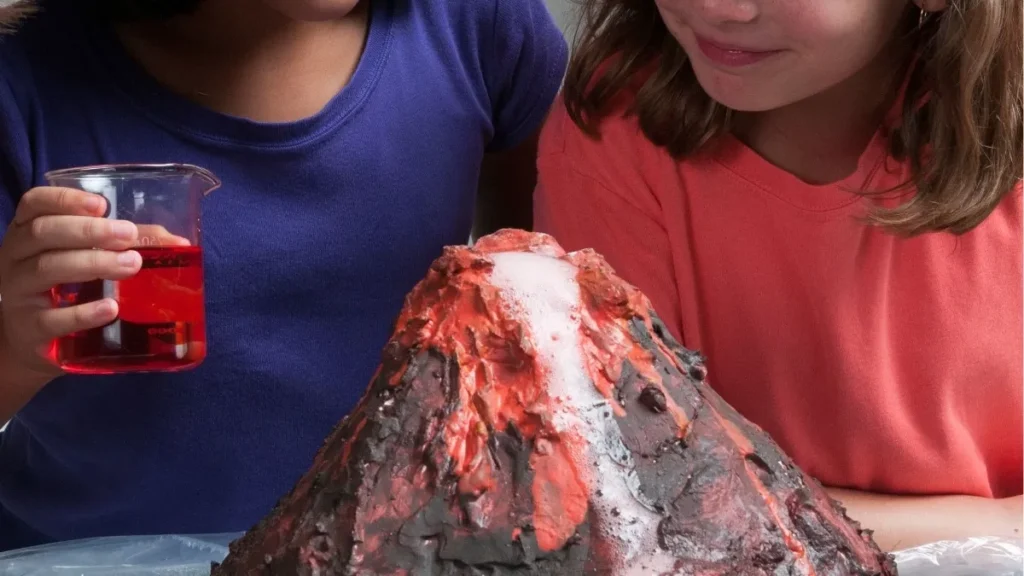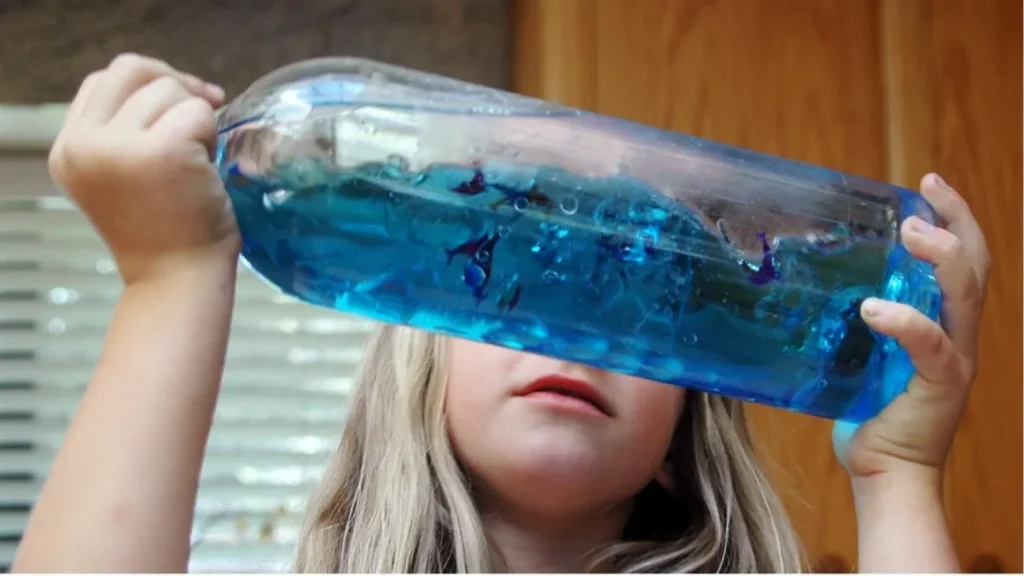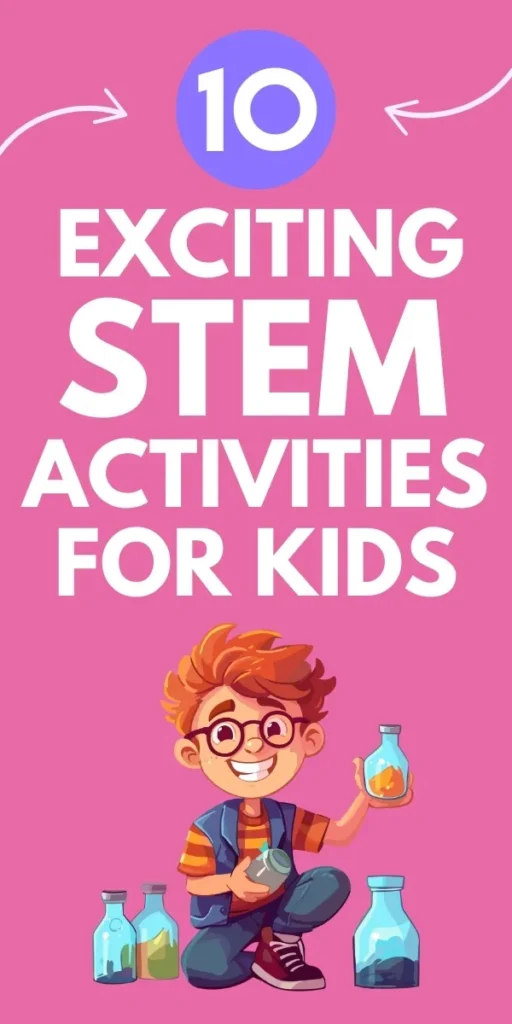In a world increasingly driven by science and technology, fostering a foundational understanding of these fields in young children is crucial.
STEM activities, which seamlessly integrate Science, Technology, Engineering, and Math, offer a powerful and engaging way to achieve this.
These activities go beyond rote memorization, instead encouraging a spirit of curiosity, problem-solving, and creativity.
STEM Activities for middle school kids and toddlers
Science, Technology, Engineering, and Math (STEM) can be fun! These 10 engaging STEM activities use everyday household items to introduce young minds to basic concepts in a playful way . Let’s get those curious minds working!
Activity 1: Volcano Boom! (Baking Soda Volcano)

Age Group: 3-8 years old
Materials: Baking soda, vinegar, dish soap (optional), shallow tray, modeling clay or play dough, construction paper (optional)
How to Perform: Erupt with excitement and explore chemical reactions with a baking soda volcano! Mold the modeling clay or play dough on the shallow tray to create a volcano shape. Carefully add baking soda inside the volcano crater. Pour a little vinegar into the volcano and watch it fizz and erupt! Add a drop of dish soap for a more foamy eruption. You can decorate the volcano with construction paper for a more dramatic effect. (Adult supervision recommended with vinegar)
Area of Development: Scientific exploration, Observation skills, Chemical reactions
Activity 2: Marshmallow Launcher
Age Group: 4-8 years old
Materials: Paper towel tube, rubber band, marshmallows, craft sticks (optional)
How to Perform: Fire up some STEM fun and explore force and motion with a marshmallow launcher! Cut a rubber band so it fits around the paper towel tube. Stretch the rubber band around the tube and secure it with a craft stick (optional) on one end. Place a marshmallow inside the other end of the tube. Pull back on the stretched rubber band and let go to launch the marshmallow!
Area of Development: Science exploration, Understanding force and motion, Experimentation
Activity 3: Rainbow in a Glass

Age Group: 3-8 years old
Materials: Shallow dish, water, clear glasses or cups, coffee filters, food coloring (various colors)
How to Perform: Create a beautiful rainbow with water and color! Fill a shallow dish with water. Add drops of different food coloring around the edge of the dish. Place a coffee filter in the center of the dish, touching the water. Watch as the colors travel up the filter, creating a rainbow!
Area of Development: Scientific exploration, Observation skills, Color mixing
Activity 4: Sink or Float?

Age Group: 3-8 years old
Materials: Large bin or tub, water, various objects (plastic toys, metal spoon, cork)
How to Perform: Spark scientific curiosity with a sink or float experiment! Fill a bin or tub with water. Collect a variety of objects made from different materials (plastic toys, metal spoon, cork). One at a time, place the objects in the water and see if they sink or float. Talk about why some things float and others sink (weight, material).
Area of Development: Scientific exploration, Observation skills, Understanding density
Activity 5: Build a Tower Challenge

Age Group: 4-8 years old
Materials: Various building materials (blocks, Legos, straws, pipe cleaners, blankets)
How to Perform: Put those engineering skills to the test with a tower building challenge! Gather a variety of building materials like blocks, Legos, straws, pipe cleaners, or even blankets. Challenge your child to build the tallest tower they can. Talk about balance, stability, and different building techniques. See if they can build a tower that can hold a small stuffed animal on top!
Area of Development: Engineering skills, Problem-solving, Spatial reasoning
Activity 6: Dancing Dough Science

Age Group: 3-8 years old
Materials: Cornstarch, baking soda, water, food coloring (optional), music (optional)
How to Perform: Explore the science of non-Newtonian fluids with dancing dough! Mix equal parts cornstarch and baking soda in a bowl. Slowly add water, a little at a time, until the mixture forms a moldable dough. You can add a few drops of food coloring for extra fun. Play music and observe how the dough changes texture. When you press on it, it feels solid, but when you let go, it flows like a liquid!
Area of Development: Scientific exploration, Observation skills, Understanding states of matter
Recommended: 300+ Fun & Easy Toddler Activities for Hours of Fun
Activity 7: Coded Treasure Hunt
Age Group: 5-8 years old Materials: Paper, crayons, small toys or treats (hidden treasure)
How to Perform: Introduce basic coding concepts with a fun treasure hunt! Create a treasure map with coded directions using arrows, shapes, or symbols. Hide small toys or treats around the house and write down the coded instructions on the map to find them. Your child can follow the code to crack the treasure hunt!
Area of Development:* Introduction to coding, Following directions, Problem-solving
Activity 8: Egg Drop Challenge

Age Group: 5-8 years old
Materials: Raw eggs (adult supervision required), various household materials (cardboard, cotton balls, bubble wrap, tape)
How to Perform: Put on your engineering hat and protect the egg! Challenge your child to design a container using household materials like cardboard, cotton balls, bubble wrap, and tape. The goal is to create a container that will protect a raw egg from breaking when dropped from a certain height. Test out the designs and see which one keeps the egg safe! (Adult supervision required with raw eggs)
Area of Development:* Engineering skills, Problem-solving, Experimentation
Activity 9: Make a Message in a Bottle

Age Group: 4-8 years old
Materials: Empty plastic bottle, water, paper, pencil, string
How to Perform: Explore buoyancy and create a secret message! Write a secret message on a piece of paper. Roll the paper up tightly and tie it securely with a string. Place the message inside the empty plastic bottle. Fill the bottle with water and screw the cap on tight. Does the bottle sink or float? This is a fun way to demonstrate buoyancy and water density.
Area of Development: Scientific exploration, Observation skills, Understanding buoyancy
Activity 10: Flashlight Morse Code
Age Group: 5-8 years old Materials: Flashlight, paper, pencil
How to Perform: Introduce the concept of communication with a flashlight Morse code activity! Look up a simple Morse code chart that shows letters represented by short and long flashes of light. Practice sending and receiving messages with a flashlight in a dark room. This is a fun way to learn basic coding and communication skills.
Area of Development: Introduction to coding, Communication skills, Following directions

Conclusion
By incorporating STEM activities into your child’s learning journey, you’ll be equipping them with the tools they need to not only excel in academic pursuits but also to approach challenges with a thoughtful and innovative mindset.
These activities spark a love for learning that extends far beyond the classroom, fostering a lifelong fascination with the world around them.